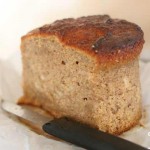
“What have you done this past week?” my husband asked rhetorically. “You gave birth. And then you made a loaf of bread.”
“Two loaves,” I pointed out.
“No one would believe you if you told them,” he finished.
What can I say? This bread really is next to instant — presuming you’ve planned in advance. I whipped up a batch of dough — 5 minutes of mixing — and stuck it into the fridge before leaving for the hospital, and when we came home four or five days later, my husband plopped it into a pot and it went straight into the oven. One hour later, and poof! We had a fresh loaf of sourdough.
This is my interpretation of a classic sourdough recipe. For some people, bread is a craft, an art form, a calling. Lives have been spent trying to achieve the perfect loaf. That loaf is generally baked at a temperature my wimpy oven can’t actually reach.
Me? I want the best results possible with minimum effort. Mix the ingredients. Leave the dough to rise at least overnight, if not for several days. Dump into a pot, put into an unheated oven, and bake for an hour. No fuss.
Precision? Nah. Kneading? Nope. When you don’t have time to cook, it sure doesn’t hurt to have a hearty bread sitting around. (Literally: When it’s at least half whole wheat, it can sit out for even 4 days before it becomes unpleasantly stale.) As an added bonus, a handsome loaf like this would probably cost 30 shekels or more at your average Tel Aviv bakery.
My bread is based on this recipe from Chocolate and Zucchini, where you can find great detail about the process and its technicalities. (C&Z credits Flo Makani with the original 1:2:3 bread recipe — 1 part starter, 2 parts water, 3 parts flour). You also can find many detailed explanations online as to how to make sourdough starter. My instructions here are simplified, but they work.
As I said, this bread is nearly instant. Nearly — you need to have sourdough starter on hand. Making the starter takes several days (but minimal time investment), and it’s a one-time thing. You also need to mix the dough at least a day in advance, after which it can be left to rise on the counter for a day, or in the fridge for several days (I haven’t tried leaving it for longer than a week).
Also, the choice of baking dish is important — the beautiful crust is a product of the lidded cast-iron pot in which the bread is baked. This 27-centimeter sauteuse, to be precise — this online store has the best prices for cast iron that I’ve found in Israel; alternatives outside Israel include this 3-quart pot and this 5-quart pot (If you buy via Amazon I receive a small commission; if you buy via the Israeli site, I receive the satisfaction of knowing you got a good deal). A pot made from a thinner metal that doesn’t retain heat as well won’t produce the same professional-looking results.
So here you go, my bastardized version of artisan sourdough, with an effort-to-reward ratio that can’t be beat.

To make the starter:
In a container, mix 1/4 cup flour with 1/4 cup water, and let it sit on your counter for a day. It should start picking up natural yeasts
from the air. (I actually added a small amount of yeast, too — about 1/4 teaspoon — just to make sure my starter got off on the right foot, although technically this means it’s not real sourdough starter. Not that I care — it tastes fine.) The following day, add another 1/4 cup flour and 1/4 cup water. Repeat for another three days.
Now, you should have a starter with a pungent vinegar smell.
Store your starter in the fridge, pouring off at least half once a week or as needed, and replenishing with equal volumes of flour and water (I need to add 1/2 cups of each to replace what I use in this recipe). Most sites say to feed your starter once a week, but I think I’ve occasionally left it for two weeks without feeding it.
For one 1.2 kilo loaf of easy sourdough bread:
- 200 grams starter
- 400 grams water
- 600 grams flour of your choice, including at least 300 grams white flour: I usually use 300 grams white flour, 200 grams whole wheat and 100 grams rye, but you can vary
- 2 teaspoons salt
- optional additions of your choice: I usually mix flax seeds (say, 70 grams for those who like measurements) and wheat germ (say, 20 grams) into the dough, and use ground oatmeal to coat the crust; walnuts and raisins are also a nice addition
- oil and extra flour for the pot
Prep time: maybe 10 minutes in total, over at least 2 days, plus at least 24 hours of rising time. Cook time: 1 hour.
Place a large bowl on a kitchen scale, and measure out your starter, water and flour. Mix until all the liquid is absorbed into the flour and you have a shaggy dough.
Top the shaggy dough with your salt and optional additions.
Here’s where the recipe gets as simple or labor-intensive as you want to make it. If you want the quick version, mix in everything until incorporated, stick the bowl in a plastic bag and leave it on the counter (if you want the bread the following day) or in the fridge (if you want the bread more than one day later) until you’re ready to bake it.
If you want to make things slightly more complicated, then wait an hour or so to mix in the salt, etc., to give the yeast a head start without the salt interfering). Once the dough has doubled in volume — this will take 6 hours on a warm day, or overnight in the fridge — you can stir it down (i.e. “knead” it), preferably the night before baking, and let it rise again. To be honest, though, I’m not sure these traditional bread-making steps make a difference in the final product.
When your dough has risen, you’re ready to bake the bread. Lightly oil your cast-iron pot if it isn’t already oiled, and cover the bottom of the pot with a very liberal layer of flour — a few millimeters. If you want to coat the crust with something, i.e. oatmeal or seeds, pour a layer of that on top of the flour. Pour your dough from the bowl into the pot — it will be gooey and lumpy.
Wet your hands, and fold the sides of the dough toward the center of the loaf several times, until you have a roundish ball that can be flipped over. Don’t handle the dough too much, since you don’t want to deflate it. Flip the dough so that the folded seams face down and the oatmeal (or flour) coating is on top. Even if this step goes wrong, and your dough gets all sticky and messy, the bread still probably will come out fine.
Score the top of the loaf with a knife to make a pattern of your choosing.
Put the lid on the pot, put the pot into your unheated oven and turn the oven onto its highest setting (mine gets up to about 220 degrees Celsius).
After an hour, turn off the oven and take out the pot — be very careful handling hot cast iron, it gives nasty burns. Remove the lid, admire your lovely no-effort loaf, and take the bread out of the pot (I just flip it over onto my counter). Place on a rack to cool.
Ta-da!





